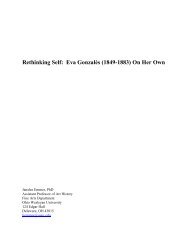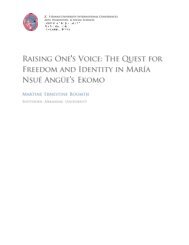2012 HUIC - Hawaii University International Conference on Arts and ...
2012 HUIC - Hawaii University International Conference on Arts and ...
2012 HUIC - Hawaii University International Conference on Arts and ...
Create successful ePaper yourself
Turn your PDF publications into a flip-book with our unique Google optimized e-Paper software.
<str<strong>on</strong>g>2012</str<strong>on</strong>g> <str<strong>on</strong>g>HUIC</str<strong>on</strong>g> - <str<strong>on</strong>g>Hawaii</str<strong>on</strong>g> <str<strong>on</strong>g>University</str<strong>on</strong>g> <str<strong>on</strong>g>Internati<strong>on</strong>al</str<strong>on</strong>g> <str<strong>on</strong>g>C<strong>on</strong>ference</str<strong>on</strong>g> <strong>on</strong> <strong>Arts</strong> <strong>and</strong> Humanities<br />
January 8 - 10, <str<strong>on</strong>g>2012</str<strong>on</strong>g>, Ala Moana Hotel, H<strong>on</strong>olulu <str<strong>on</strong>g>Hawaii</str<strong>on</strong>g>, USA<br />
Exploring the Essence of Dance<br />
Darlene O'Cadiz<br />
Theatre <strong>and</strong> Dance Department at California State <str<strong>on</strong>g>University</str<strong>on</strong>g> Fullert<strong>on</strong><br />
P.O. Box 6850, Fullert<strong>on</strong>, CA 92834-6850<br />
docadiz@fullert<strong>on</strong>.edu<br />
The paper I am submitting is actually a porti<strong>on</strong> of the first chapter of the text book for my<br />
Dance <strong>and</strong> Cultural Diversity class at California State <str<strong>on</strong>g>University</str<strong>on</strong>g> Fullert<strong>on</strong> so<strong>on</strong> to be<br />
published by Cognella/<str<strong>on</strong>g>University</str<strong>on</strong>g> Reader in January <str<strong>on</strong>g>2012</str<strong>on</strong>g>.<br />
Abstract<br />
This paper explores the purpose of dance from the most rudimentary level<br />
referencing metaphor <strong>and</strong> justifying the study of dance as part of the quest to<br />
underst<strong>and</strong> humanity. Alan Lomax's c<strong>on</strong>tributi<strong>on</strong>s to preserving dance for<br />
anthropological study al<strong>on</strong>g with his theories presented in the documentary "Dance<br />
<strong>and</strong> Human History" is examined. The idea is presented that dance is a Universal<br />
language <strong>and</strong> has the capacity to communicate <strong>on</strong> a deeper level reflecting belief<br />
systems <strong>and</strong> social practices to genuinely express cultural attitudes.<br />
Darlene O'Cadiz<br />
California State <str<strong>on</strong>g>University</str<strong>on</strong>g> Fullert<strong>on</strong><br />
Theatre <strong>and</strong> Dance Department
Exploring the Essence of Dance<br />
Dance is a Metaphor for life. Dance seems to mimic not <strong>on</strong>ly natural human<br />
movements <strong>and</strong> experiences, but also complex natural processes. There have been many<br />
metaphors using dance as the reference. Scientists talk about the dance of particles <strong>and</strong><br />
organisms. The idea of something in c<strong>on</strong>stant moti<strong>on</strong>, cooperating, flowing rhythmically<br />
triggers <strong>on</strong>e to compare it with the idea of dance. As Santhanam Nagarajan states in his<br />
article Carl Sagan, Fritjof Capra <strong>on</strong> The Dance that Reveals the Mysteries of Universe?<br />
Part II " Physicists speak of the c<strong>on</strong>tinuous dance of sub-atomic matter which goes <strong>on</strong><br />
all the time. They have actually used the words dance of creati<strong>on</strong> <strong>and</strong> destructi<strong>on</strong> or<br />
energy dance. This naturally comes to mind when you see some of the pictures of<br />
particles taken by physicists in their bubble chambers." Writers also often describe ideas<br />
of life using the metaphor of dance. Nietzsche uses metaphors of dance to describe life<br />
<strong>and</strong> <strong>on</strong>es c<strong>on</strong>necti<strong>on</strong> to the earth yet a desire to dance with the gods <strong>and</strong> be <strong>on</strong>e with the<br />
art. He refers to "primal unity" surrendering will in the Di<strong>on</strong>ysian ecstasy dance of the<br />
reveler:<br />
In s<strong>on</strong>g <strong>and</strong> dance man expresses himself as a member of a higher<br />
community: he has forgotten how to walk <strong>and</strong> speak <strong>and</strong> is <strong>on</strong> the way<br />
toward flying into the air, dancing…he feels himself a god, he himself<br />
now walks about enchanted, in ecstasy, like the gods he saw walking in<br />
his dreams…He is no l<strong>on</strong>ger an artist, he has become a work of art: in<br />
these paroxysms of intoxicati<strong>on</strong> the artistic power of all nature reveals<br />
itself. (Nietzsche, Friderich (1871), The Birth of Tragedy) p.38<br />
Defining dance is like defining life to some people. A comm<strong>on</strong> B<strong>on</strong>tu greeting is "What<br />
do you dance?" meaning how do you express life? What is life about? Exploring different<br />
cultures <strong>and</strong> their dance styles sparks the pursuit to discover the human spirit <strong>and</strong> how<br />
people express life through movement. Witness the dance as it reflects belief systems <strong>and</strong><br />
societies structure in different cultures. Discover life <strong>and</strong> how to live it revealed in the<br />
dance.<br />
What is Dance?<br />
Before we can explore the history of dance, we must first define what dance is,<br />
<strong>and</strong> why humans do it. Most simply put, dance is movement to rhythm. The first instinct<br />
of a human being is to put his or her body in moti<strong>on</strong>. While still in the mother’s womb a<br />
baby listens to the rhythm of the mother’s heartbeat <strong>and</strong> has the urge to move. Before<br />
language is learned <strong>and</strong> developed, communicati<strong>on</strong> is revealed by means of movement<br />
<strong>and</strong> gestures. Movement is the most basic experience of life essential to human survival.
But even though dance is a form of moving, its functi<strong>on</strong> goes bey<strong>on</strong>d the simple<br />
movements humans rely <strong>on</strong> everyday. Dance is expressi<strong>on</strong>. Webster's dicti<strong>on</strong>ary defines<br />
dance as, “Moving rhythmically to music,” but it is so much more. Dance is a vehicle that<br />
has the power to unite mind, body, soul; it is a n<strong>on</strong>verbal means of communicating in the<br />
universal language, expressing abstract ideas <strong>and</strong> emoti<strong>on</strong>s by emitting an energy that can<br />
be recognized <strong>and</strong> felt by the affected observer. It has the power to transcend cultural<br />
boundaries <strong>and</strong> speak to people <strong>on</strong> a deep, spiritual level.<br />
The more subtle <strong>and</strong> complex comp<strong>on</strong>ents of dance are centering <strong>and</strong> breath.<br />
These highly emoti<strong>on</strong>al elements are what allow a dancer to be capable of authentic<br />
expressi<strong>on</strong>.<br />
Centering is related to the basic comp<strong>on</strong>ent of balance. In order to achieve a sense of<br />
balance, a dancer must engage the solar plexus <strong>and</strong> lower torso. This porti<strong>on</strong> of the body<br />
is where most of the body’s crucial organs are located. Focusing <strong>on</strong> this area gives a<br />
dancer a greater sense of strength <strong>and</strong> c<strong>on</strong>nectedness within his or her own body. This<br />
stability allows the dancer to bring forth a spiritual essence that can be displayed <strong>and</strong><br />
expressed with c<strong>on</strong>fidence. These deep feelings can be seen <strong>and</strong> felt by the audience.<br />
Dance is not the <strong>on</strong>ly practice that is aware of the power that comes from focusing <strong>on</strong><br />
<strong>on</strong>e’s center. Centering has also been used as a term in ancient philosophies <strong>and</strong> religious<br />
practices to define a pathway for realizing bliss <strong>and</strong> inner peace. Zen masters refer to it as<br />
a way to focus inward, while the Quakers used the term "centering down," to explain a<br />
state of focused attenti<strong>on</strong>, of attentive listening to <strong>on</strong>e’s inner voice. (Richards, 1989<br />
p.xx)<br />
Breathing <strong>and</strong> Breath are essential to all humans. Breath is life, we must breathe to live<br />
<strong>and</strong> move. More specifically, our muscles need oxygen in order to resp<strong>on</strong>d to the<br />
comm<strong>and</strong> of our brain. In dance, an awareness <strong>and</strong> c<strong>on</strong>trol over the breath allows the<br />
dancer to maintain a sense of rhythm. Most dances are synchr<strong>on</strong>ized to some form of<br />
music or sound. If the music is faster, the dancer must move faster <strong>and</strong> therefore breathe<br />
faster. If the music <strong>and</strong> dance is slow <strong>and</strong> el<strong>on</strong>gated, the dancer will be better able to<br />
perform if he or she focuses <strong>on</strong> taking deep <strong>and</strong> deliberately el<strong>on</strong>gated breaths. The<br />
dances of some cultures employ chanting, <strong>and</strong> these dances require <strong>and</strong> even deeper focus<br />
<strong>on</strong> the breathing patterns. But regardless of the type of dance, a dancer must be aware of<br />
breath to get oxygen to the part of the body producing the energy to move. It takes<br />
c<strong>on</strong>centrati<strong>on</strong> <strong>and</strong> practice to learn to breathe efficiently while moving, but <strong>on</strong>ce this<br />
element is mastered, a dancer is able to express a greater sense of grace <strong>and</strong> c<strong>on</strong>trol.<br />
The Essence <strong>and</strong> Origins of Dance<br />
When studying the history <strong>and</strong> development of dance, we must start at the beginning.<br />
Where <strong>and</strong> when did dance originate? The answer is simple: dance has existed for as l<strong>on</strong>g<br />
as mankind has. It is believed by many to be the first means of artistic expressi<strong>on</strong>,<br />
preceding even ancient forms of music <strong>and</strong> painting. In primitive societies, dance was<br />
both a social <strong>and</strong> ritualistic practice. Primitive men danced to celebrate every aspect of<br />
life. They danced to appease the Gods <strong>and</strong> give thanks to them, believing it would please
them <strong>and</strong> keep them from causing natural disasters <strong>and</strong> other forms of calamity. They<br />
also danced to express emoti<strong>on</strong> <strong>and</strong> to underst<strong>and</strong> their relati<strong>on</strong>ship with nature.<br />
Many early peoples believed that when they danced with a particular energy <strong>and</strong> rhythm,<br />
they could bring about a desired effect. For example, some cultures believed that a wellexecuted<br />
rain dance could bring rain. Rhythmic movement was seen as <strong>on</strong>e way to<br />
communicate with the Gods. Early man had many elements to deal with, including<br />
natural catastrophes. Without the aid of modern science, these events often seemed<br />
r<strong>and</strong>om <strong>and</strong> inexplicable. They attributed these events to the will of the spirit world.<br />
Often the meditative collaborati<strong>on</strong> of tribal musicians <strong>and</strong> dancers would send the<br />
performers into what was thought to be an altered c<strong>on</strong>sciousness. This was believed to be<br />
a sign of divine presence. In this state of being, the participants often claimed to<br />
commune with the spirit world, <strong>and</strong> receive messages <strong>and</strong> instructi<strong>on</strong>s for how to survive.<br />
While to the modern viewpoint, these ideas may seem illogical, ritualistic practices, such<br />
as dance, were <strong>on</strong>e way that ancient peoples could explain or cope with forces bey<strong>on</strong>d<br />
their c<strong>on</strong>trol. They danced with the hope that it could influence the decisi<strong>on</strong>s of the Gods.<br />
And when a desired result followed their dance, such as a heavy rainfall following a rain<br />
dance, it gave people a sense that they had some impact <strong>on</strong> their situati<strong>on</strong>s. It made them<br />
feel intuitive <strong>and</strong> powerful.<br />
In fact, some of the earliest rock paintings show dancers, indicating that it was a wellestablished<br />
part of primitive existence. For example, Archeologists have discovered<br />
prehistoric rock paintings from the Paleolithic era (circa 17,500 BC) in Lascaux, France<br />
that depict dancing figures. Many other primitive drawings <strong>and</strong> paintings found in caves<br />
<strong>and</strong> burial tombs around the world attest to the fact that dance was a major part of<br />
expressing life.<br />
The well-known dance critic, John Martin discusses the significance of dance in ancient<br />
cultures:<br />
"If we go back to the earliest times, we find that primitive men danced<br />
when they were deeply moved…Whenever the primitive mind came<br />
into c<strong>on</strong>tact with something that happened without his having anything<br />
to do with it, something with the element of mystery <strong>and</strong> supernaturalism,<br />
he danced" (Martin, 1989 p.8-9)<br />
Dance has survived as a means of communicati<strong>on</strong> <strong>and</strong> a way of preserving traditi<strong>on</strong>s in<br />
different communities in different cultures. The ritual of dance c<strong>on</strong>nects the dancer to a<br />
supreme force outside of <strong>on</strong>eself. Social dance c<strong>on</strong>nects the dancer to the tribe <strong>and</strong> others<br />
in the community. The art of dance brings self-awareness to the dancer <strong>and</strong> their audience<br />
through storytelling <strong>and</strong> expressi<strong>on</strong> of emoti<strong>on</strong>.<br />
Explanati<strong>on</strong> of Alan Lomax's study of Dance in Human History
Since dance is the most repetitious, synchr<strong>on</strong>ic of all expressive behaviors, it has turned<br />
out to be a kind of touchst<strong>on</strong>e for human adaptati<strong>on</strong>. Alan Lomax, 1975<br />
Alan Lomax was an anthropologist interested in analyzing dance from different cultures,<br />
<strong>and</strong> identifying communicati<strong>on</strong> that occurred <strong>on</strong> a kinetic <strong>and</strong> subc<strong>on</strong>scious level. He<br />
searched relentlessly for footage of dance from around the world particularly, in remote<br />
locati<strong>on</strong>s. In his article, "Toward an Ethnographic Film Archive" Lomax expresses his<br />
c<strong>on</strong>cern about the changing world <strong>and</strong> the threat this had to primitive cultures. He<br />
believed that the negative bi-product of scientific progress <strong>and</strong> modernizati<strong>on</strong> was that it<br />
could cause these cultures to lose their traditi<strong>on</strong>s, rituals, <strong>and</strong> art. Dance in particular, was<br />
in extreme danger. Unlike a painting or sculpture, which can be preserved in its original<br />
form or reproduced in photographs, dance is an ephemeral art, <strong>and</strong> can <strong>on</strong>ly be<br />
understood by experiencing or observing it. Written descripti<strong>on</strong>s can <strong>on</strong>ly hint at the<br />
message the actual kinetic movement displays. Thus, Lomax felt it crucial that cultural<br />
dances be documented not through static media such as photography or written<br />
descripti<strong>on</strong>s, but through film. His film, Dance in Human History, produced in 1976,<br />
makes use of the footage he collected to dem<strong>on</strong>strate his theory of movement defining<br />
cultural traditi<strong>on</strong>s.<br />
At the American Anthropological Associati<strong>on</strong> meeting held in San Diego in the<br />
fall of 1970, Lomax presented his reas<strong>on</strong>s for preserving original dances <strong>on</strong> film. This<br />
presentati<strong>on</strong> was m<strong>on</strong>umental in the field of dance history, <strong>and</strong> as a direct result,<br />
anthropologist Margaret Mead was elected the president of the Anthropological Film<br />
Research Institute. Her work led to the establishment of The Ethnographic Film Archive<br />
in the Smiths<strong>on</strong>ian Institute in Washingt<strong>on</strong>, D.C. (Lomax, 1971). Alan Lomax <strong>and</strong><br />
Margaret Mead <strong>and</strong> other leading anthropologists dedicated themselves to filming <strong>and</strong><br />
archiving films of indigenous dances to help preserve the study of cultural traditi<strong>on</strong>s. The<br />
work of Lomax <strong>and</strong> Mead, al<strong>on</strong>g with John Wesley Powell led to the establishment of the<br />
Nati<strong>on</strong>al Anthropological Archives in 1979.<br />
Alan Lomax created the term Choreometrics to describe his study of dance as a form of<br />
expressive behavior. He took advantage of the film archive <strong>and</strong> analyzed dance styles<br />
from around the world, classifying them by the type of repetitive movements found in<br />
each culture’s dances. One of his most groundbreaking discoveries was a correlati<strong>on</strong><br />
between the type of dance movement a culture participated in, <strong>and</strong> that culture’s<br />
ec<strong>on</strong>omic status <strong>and</strong> st<strong>and</strong>ing. He described movement types in terms of dimensi<strong>on</strong>s. The<br />
most basic dance dimensi<strong>on</strong> is <strong>on</strong>e-dimensi<strong>on</strong>al style. It c<strong>on</strong>sists of linear (straight up<br />
<strong>and</strong> down) movements, which reflected the kind of work movements some<strong>on</strong>e uses when<br />
working with st<strong>on</strong>e or wood. He determined that 70% of simple ec<strong>on</strong>omies employ a<br />
<strong>on</strong>e-dimensi<strong>on</strong>al movement style. For example, people working with st<strong>on</strong>e or wood must<br />
apply careful straight strokes in order to carve into these hard <strong>and</strong> brittle mediums, <strong>and</strong><br />
also to skin animals for food <strong>and</strong> pelts clothing. Meanwhile, the two-dimensi<strong>on</strong>al style<br />
uses curved or circular movements. 80% of the ec<strong>on</strong>omies that used metal tools like<br />
sickles, which require a semicircular slashing moti<strong>on</strong> to cut wheat or other materials, also
used that kind of moti<strong>on</strong> in their dance. Examples of this two-dimensi<strong>on</strong>al style can be<br />
seen in many dances that originated in Africa, <strong>and</strong> also in some European dances, such as<br />
the Spanish Jota. Finally, three-dimensi<strong>on</strong>al movement styles use a spiral moti<strong>on</strong>,<br />
which mimics water wheels used in Asia <strong>and</strong> Europe for agricultural irrigati<strong>on</strong>. 80% of<br />
these more sophisticated ec<strong>on</strong>omies use the full body spin in their dance styles. The<br />
correlati<strong>on</strong> between the moti<strong>on</strong> of a culture’s daily tasks <strong>and</strong> the type of moti<strong>on</strong>s found in<br />
that culture’s dances suggest that these dances were meant to express or record specific<br />
aspects of their civilizati<strong>on</strong>s. On the other h<strong>and</strong>, if these correlati<strong>on</strong>s were not c<strong>on</strong>scious,<br />
Lomax’s theory is supported by what we know about human muscle memory, which<br />
naturally lends itself to any repetitive bodily moti<strong>on</strong>. Even when these cultures used<br />
movement as a means of release <strong>and</strong> recreati<strong>on</strong>, they tended to move in the same way as<br />
they did when working.<br />
In additi<strong>on</strong> to his classificati<strong>on</strong> of dimensi<strong>on</strong>al movement, Lomax also defined single<br />
unit <strong>and</strong> multi-unit movement styles. The single unit style uses a solid torso, mostly<br />
moving the legs, feet <strong>and</strong> arms <strong>and</strong> sometimes bending or using a rhythmic rocking<br />
moti<strong>on</strong> forward <strong>and</strong> back a the waist. 85% of the cultures that displayed this kind of<br />
dance were from patriarchal hunting cultures. They also tended to exist in cultures from<br />
colder climates. Meanwhile, multi-unit styles use an articulate torso, in which there is<br />
movement in the hips <strong>and</strong> undulati<strong>on</strong> in the ribcage. 90% of cultures displaying multiunit<br />
styles of dance are from matriarchal <strong>and</strong> agricultural societies. These styles are found<br />
in warmer <strong>and</strong> often tropical climates. One explanati<strong>on</strong> for the difference styles of dances<br />
found in patriarchal <strong>and</strong> matriarchal societies is that in matriarchal <strong>and</strong> agricultural<br />
societies, there is a greater value of fertility. The hip rocking moti<strong>on</strong>s found in these<br />
cultures are representative of sexual moti<strong>on</strong>, <strong>and</strong> can be seen as a way to prepare a pers<strong>on</strong><br />
for sexual activity.<br />
The purpose of Dance<br />
While modern science informs us that human rituals do not affect envir<strong>on</strong>mental forces,<br />
that rain dances do not in fact, cause rain, dance is still an effective means of<br />
communicati<strong>on</strong> <strong>and</strong> a way of preserving traditi<strong>on</strong>s in different communities <strong>and</strong> cultures.<br />
The ritual of dance has the power to c<strong>on</strong>nect. Primitive people danced in h<strong>on</strong>or <strong>and</strong><br />
celebrati<strong>on</strong> of every aspect of life. There were dances to give thanks <strong>and</strong> h<strong>on</strong>or the gods<br />
<strong>and</strong> ancestors al<strong>on</strong>g with dances to cast out evil spirits. There were dances to celebrate<br />
the rites of passage like birth, puberty, marriage <strong>and</strong> death. There were dances to prepare<br />
for the hunt <strong>and</strong> war. Some dances were used to tell stories <strong>and</strong> pass <strong>on</strong> tribal traditi<strong>on</strong>s.<br />
A str<strong>on</strong>g <strong>and</strong> mobile body was vital to survival in prehistoric times <strong>and</strong> dancing helped to<br />
keep the people str<strong>on</strong>g. Ritual dances <strong>and</strong> social dances were a way of life.<br />
In our society today we still celebrate certain aspects of life with dance. Children<br />
naturally dance to music as they express happiness. Teenagers <strong>and</strong> young adults go to<br />
school dances or clubs to dance <strong>and</strong> socialize. There are coming of age dances that are<br />
still celebrated. In the Hispanic community the Quinceanera or girls 15th birthday is a<br />
celebrati<strong>on</strong> were dance is a comp<strong>on</strong>ent. Also at the Bar Mitzvah a Jewish coming of age<br />
celebrati<strong>on</strong> for boys turning 13 a circle dance called the Hora is performed al<strong>on</strong>g with
some social dancing. Dancing is also a part of a wedding celebrati<strong>on</strong>. The Bride <strong>and</strong><br />
Groom do a first dance <strong>and</strong> their parents cut in to have <strong>on</strong>e last dance then all the guests<br />
join in to celebrate.<br />
Cultural attitudes are reflected in the dance. While watching a dance from another<br />
country where you d<strong>on</strong>'t know the language <strong>on</strong>e can somehow interpret the basic idea.<br />
This is because movements expressing emoti<strong>on</strong>s transcend language. As part of the<br />
human race we all seem to feel <strong>and</strong> underst<strong>and</strong> the same emoti<strong>on</strong>s. All human beings<br />
experience joy, sorrow, h<strong>on</strong>or, fear, gratitude, love, empathy, anger, disappointment, <strong>and</strong><br />
a multitude of emoti<strong>on</strong>s that are expressed in body movements <strong>and</strong> gestures al<strong>on</strong>g with<br />
the minds intenti<strong>on</strong>s that can be recognized by the sensitive observer. Because of the<br />
awareness of different cultures <strong>and</strong> blending of different cultures around the world, dance<br />
styles from different cultures are blending too.<br />
Dance can express feelings <strong>and</strong> emoti<strong>on</strong>s but can it also heal the spirit or even the world?<br />
In the popular reality TV show "Dancing with the Stars" Steven Guttenburg <strong>on</strong>e of the<br />
c<strong>on</strong>testants in seas<strong>on</strong> 6 made the comment that dancing with a partner requires a level of<br />
cooperati<strong>on</strong> <strong>and</strong> communicati<strong>on</strong> that is highly sophisticated <strong>and</strong> if the world leaders<br />
would learn the cooperati<strong>on</strong> <strong>and</strong> coordinati<strong>on</strong> of dancing the world would be a better<br />
place.<br />
It is important to study dance history to c<strong>on</strong>template <strong>and</strong> gain underst<strong>and</strong>ing of the<br />
rhythms of life, to realize its universal communicati<strong>on</strong> possibilities, <strong>and</strong> to better<br />
underst<strong>and</strong> cultural differences <strong>and</strong> similarities as a means of broadening our awareness<br />
of humanity.<br />
Bibliography<br />
Lomax, A. (1971), Toward an ethnographic film archive. Filmmakers Newsletter,<br />
February Vol 4 #4 p. 1-12, retrieved from John Bishop December 1999,<br />
www.cda.ucla.edu<br />
Martin, J. (1989). The modern dance. Princet<strong>on</strong>, NJ: Dance Horiz<strong>on</strong> Books.
Nagarajan, S. (2009). Carle Sagan, Fritjof Capra <strong>on</strong> "The danc that reveals the Myteries<br />
of Universe" ? Part II. Article haul.com retrived from http://www.articlehaul.com/selfhelp/article553.htm<br />
Nietzsche, F. W. (2000). The birth of tragedy. New York:Oxford <str<strong>on</strong>g>University</str<strong>on</strong>g> Press<br />
(eBook).<br />
Richards, M.C. (1989). Centering: In pottery, poetry <strong>and</strong> the pers<strong>on</strong>. Wesleyan <str<strong>on</strong>g>University</str<strong>on</strong>g><br />
Press: Middletown C<strong>on</strong>necticut.<br />
Discussi<strong>on</strong> Questi<strong>on</strong>s<br />
Discuss each questi<strong>on</strong> <strong>and</strong> give examples to explain your c<strong>on</strong>clusi<strong>on</strong>. If you use outside<br />
sources please make reference to them <strong>and</strong> include the citati<strong>on</strong> in your written work.<br />
1. Why do human beings believe there is a force outside of themselves that c<strong>on</strong>trols life?<br />
a. Can you prove that there is?<br />
b. Why is the belief so str<strong>on</strong>g?<br />
c. Will humans always believe there is a superior being or force?<br />
2. In the 1970's Alan Lomax expressed his c<strong>on</strong>cern about the rapidly changing world <strong>and</strong><br />
the need to document traditi<strong>on</strong>al dances. How has the world changed since then?<br />
a. Do you think that most people around the world are aware of different cultures?<br />
b. What has c<strong>on</strong>tributed to the changing world?<br />
c. Has technology c<strong>on</strong>tributed to global awareness? How?<br />
3. Dance is thought to be a universal language. Why?<br />
a. Are there other ways to communicate transcending the language barrier?<br />
b. What needs to all humans from every culture have in comm<strong>on</strong>?<br />
c. What makes each culture unique?<br />
4. What kind of dances represents your generati<strong>on</strong>?<br />
a. How does this dance express the attitudes of your culture?<br />
b. Can you find a link to a culture other than American culture? Is there history?<br />
c. How does it compare to your parents generati<strong>on</strong>?







